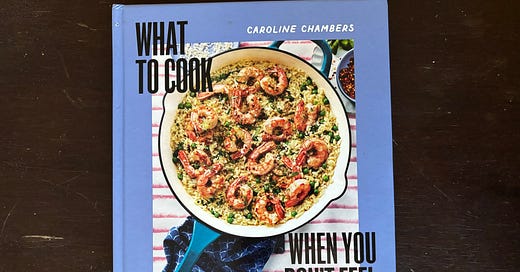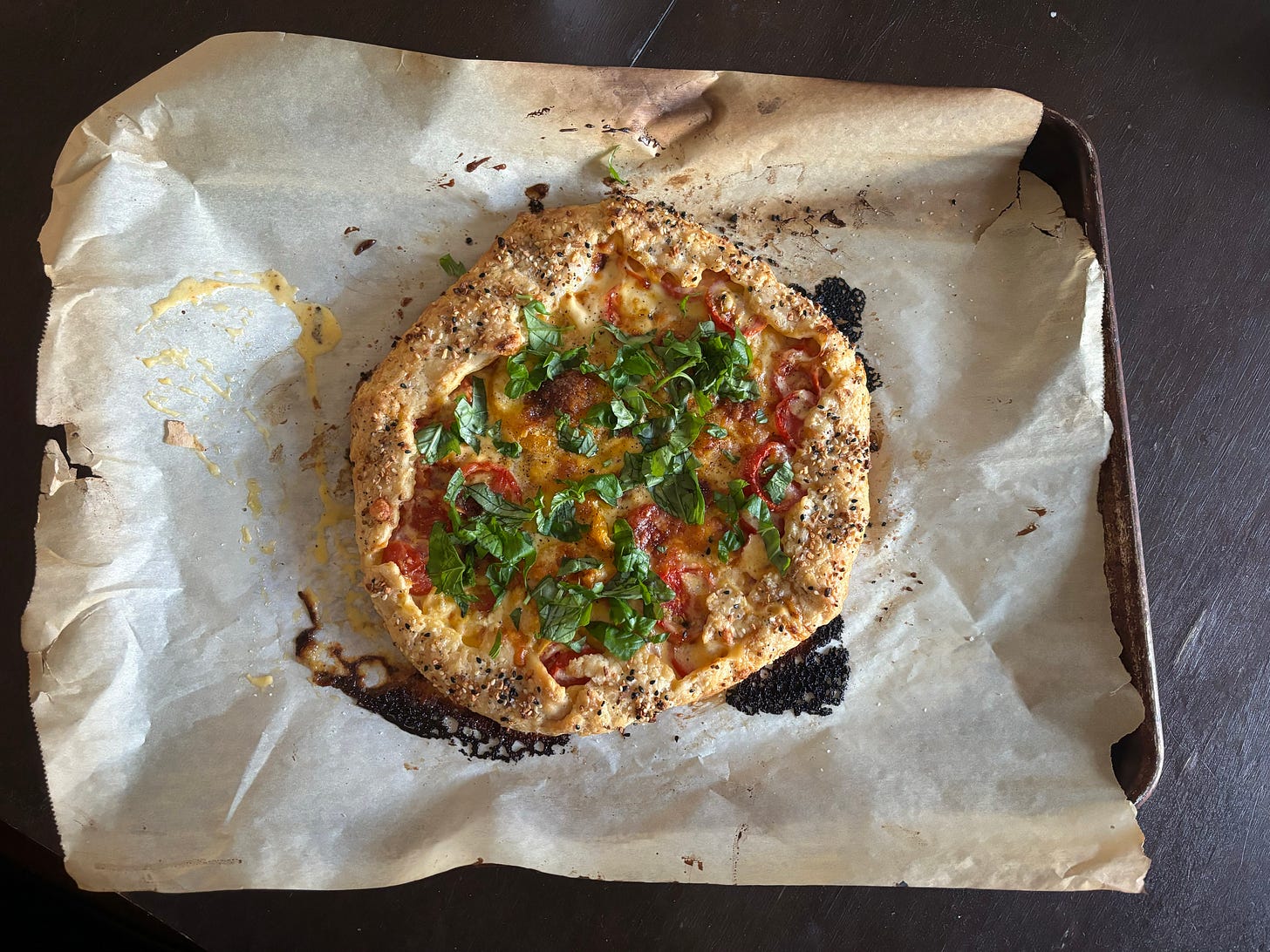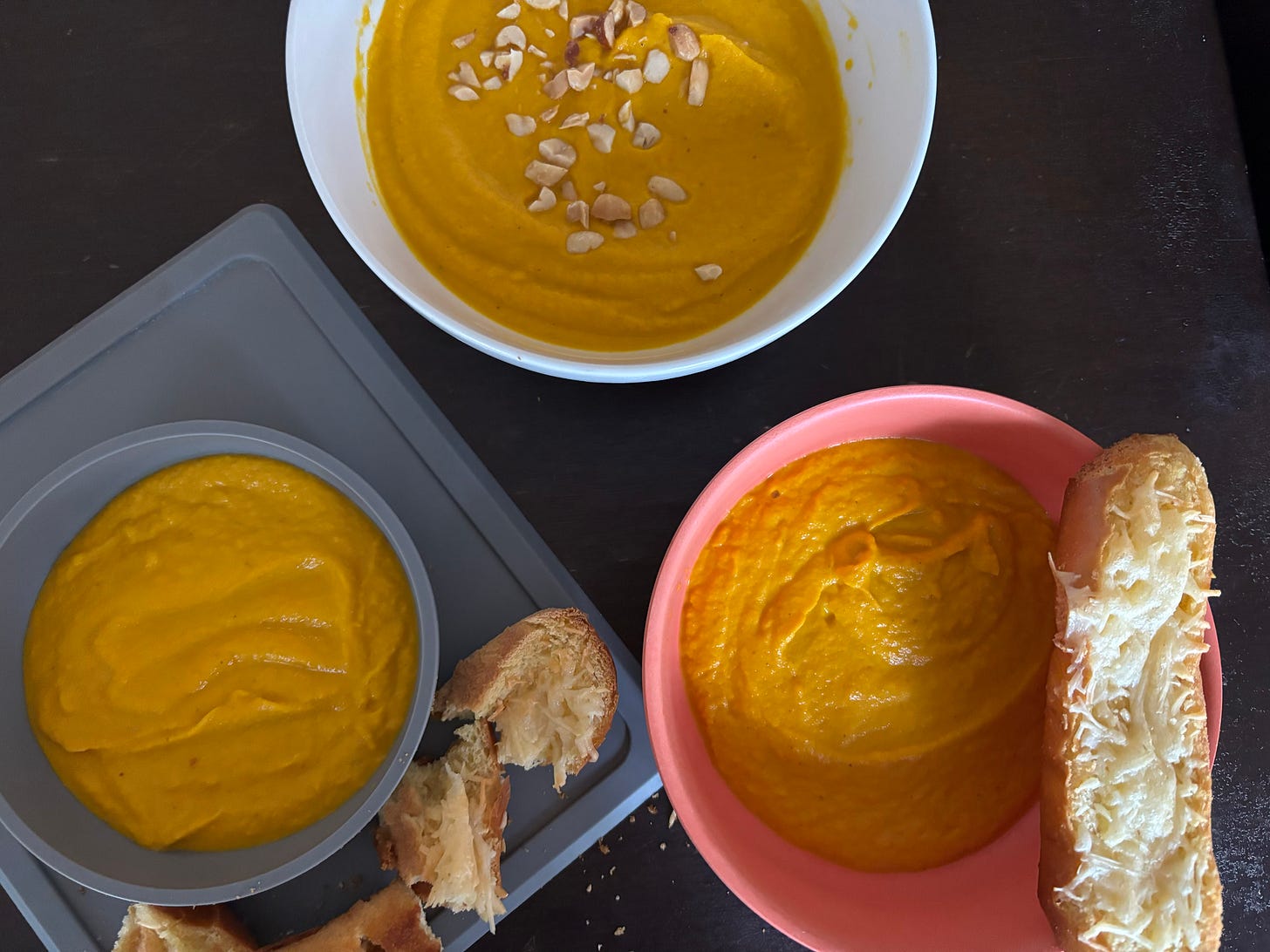What to Cook When...You Absolutely Cannot Dirty Another Dish
A Review of What to Cook When You Don't Feel Like Cooking by Caroline Chambers
I don’t want to make it a habit of starting all my posts with sorties into my plumbing issues, but I think I must mention them again because they really have shaped my cooking this past month.
If you’ve ever contended with a septic system, you very likely have a story about a septic system not working. This aspect of the rural idyll in which I find myself living, it turns out, was probably pretty inevitable, just like the day I saw a rattlesnake on my porch. Sometimes I feel like I could stand to know a little less about septic systems and rattlesnakes, but here we are.
All that being said, it’s not too bad. We are figuring it out. But for the past month we have had to drastically cut back on our water use.
In practice this means that doing dishes is a huge pain so I tried my best not to use many. Baking sheets became cutting boards and skillets became plates. It got to the point where multiple cooking vessels for one recipe felt downright gratuitous and maybe a bit depraved.
So it is with great fortune that my hydro adversity overlapped with a much-anticipated cookbook release: Caroline Chambers’ What to Cook When You Don’t Feel Like Cooking (the cookbook).
A Book Backgrounder
If you are familiar with the Substack food scene, and there’s a solid chance you are, (unless you are one of the many readers here with familial ties to me), then you are likely also familiar with Caroline Chambers and her widely beloved What to Cook When You Don’t Feel Like Cooking (the newsletter). It is one of the most subscribed and most popular food dispatches on this very platform.
I have been following Caro (as her followers know her) for a long time and waiting for this cookbook for about as long. I have actually been a subscriber since day one because I remember Caro launching it on her Instagram and calling it her “digital cookbook.” It goes without saying that this phrase had me at hello.
The newsletter came about because, as the story goes, Caro had a great idea for a second cookbook eating away at her, but she could not land a cookbook deal.1 Publishers kept saying she didn’t have enough of an online following. So she decided to launch her newsletter as a way to get her recipes out despite the barriers, and maybe to say eff you to the publishers just a bit. And it worked! Her newsletter gained her a huge digital following and, what do you know, a cookbook deal.
The newsletter, started during the high-pandemic slog, was wonderful for readers because Caro’s recipes included a substitution for nearly every single ingredient and as many shortcuts as she could come up with.
The whole ethos of the newsletter was and continues to be that no one needs to be so serious about food and cooking, and all skill levels are welcome to the party. Oh, and the food is going to be delicious, so just chill out a bit. (A message we all needed in 2020 and most of us still need today.)
And while I love the newsletter (and my dearest Heather for gifting me a subscription—hi, thank you!) I also love—and I’m not sure if you’ve clocked this yet—cookbooks. So I was always waiting for that hardback.
And when it finally came, my kitchen was half out of commission, making it both the best of times and the worst of times to test out a book of easy recipes.
Book versus Newsletter
If you are a devotee of the What to Cook newsletter, you know that one of the things that makes it so great is that Caro, as noted above, lists a substitution for every single ingredient unless absolutely crucial. On top of that, nearly every recipe has vegetarian/gluten-free/dairy-free option, and almost anything can be swapped out.
The book, due to the constraints of print I assume, does not contain swaps for every ingredient in every recipe, nor for every dietary restriction but it definitely carries over the switch-it-out energy. There’s a short “How to Swap It” section up front that encourages substitutions. There are also several recipes with “Riffs” and “Swaps”—ways to change up the recipe. So, according to the EatYourBooks.com index, there are technically 152 recipes, but there are several riffs and swaps that make it an even richer resource. (Not to mention additional suggestions on shortcuts and bulking up meals.)
A second thing to note is that the newsletter is much loved for having the ingredient amounts right in the recipe directions, so you don’t have to constantly scroll up and down to check measurements. In the style of the newsletter, the cookbook bolds the ingredients in the directions, but it does not list the amounts in the actual recipe steps. My guess is that it is not necessary because all recipes are—wonderfully—contained to a single page, no scrolling needed. But if it’s something about the newsletter you adore, then its absence is noteworthy.
Finally, Caro has stated that there are ten recipes in the book that are from the newsletter (I didn’t count). I personally love when internet recipes are put into book form because it is the way I cook most often, but if you turn into Oscar the Grouch when people reuse online content in their books, then you can ready your trash can. (Yes, I am the mother of small children, but how could you tell?)
The Recipes
The book is divided by time it takes to make the recipes: 15-ish minutes, 30 minutes, 45 minutes, 1 hour, and then a few longer options. There is a short chapter on each greens and desserts, though all main recipes are intended to be entire meals.
The book also includes two additional indexes. One is the very practical Recipes by Protein and the other is the fun and useful mood/event index, which includes What to Cook When.. You’re Feeling Especially Healthy, You’re Craving Something Cozy, You Need to Feed People Lunch, You Need to Drop Off a Meal for a Friend, You’re Craving Pasta, You’re In the Mood for a Sandwich, You Want a One-Pot/Sheet Pan Meal, You Want to Show Off, and You Want to Use Your Slow Cooker. (Alas, none for When Your Septic is Down, but we can’t have everything.)
What all dishes have in common is the What to Cook spirit: They use the minimal amount of dishes, skill, ingredients, and effort necessary to make the tastiest product.
But do note, even though “don’t feel like cooking” is in the title, this is not a dump-and-stir dinner book. You’re not just popping cans. You do have to do some cooking. Caro, however, works hard to develop her recipes in a way that makes all the steps and inputs necessary. If it’s there, it means it absolutely has to be.
It’s what to cook when you want to eat something that hits the spot, but takeout doesn’t exist, and you still have to watch two strong-willed children who categorically refuse to come inside before 5 pm, and your pipes don’t really work. Or whatever your equivalent of that is.
My Experience
Usually, when I write about cookbooks, I like to run through every recipe and write what I thought about it.
The problem, or perhaps endorsement, of this cookbook is that I cooked from it nearly exclusively for a month and I haven’t exactly stopped yet, so that would be a lot of recipe talk. I’ve condensed a bit for the sake of brevity.
The day the book arrived, I made Lemon Pancakes. They were a cottage-cheese based pancake that were a very big hit with both my children and used only, I kid you not, one bowl and one fork (hallelujah!).
We moved through the Pork Chops with Plums & Polenta, and honestly, I think my sad Walmart plums—a gambit to get my child to eat “purple peaches”—ruined this one a bit. The polenta was excellent.
Next, was the Pimento cheese Everything Bagel Galette, a riff on one of my favorite newsletter recipes. And, folks, my septic tank was getting pumped while I made this one and I accidentally made the pie crust with bread flour. My husband remembers it was good. I believe I went into a fugue state.
We followed this up with Blackened Cabbage and Salmon, Tater Tot Egg Bake, Roasted Peanut Carrot Soup, and Baked Tomato Basil Butter Pasta. All of these I threw together before school pick up so that I could let the wildlings run free for a while outside when we got home, occasionally popping in the house to stick something in the oven, and not worry too hard about dinner. Perfect! The baked pasta was especially a hit. We made it with farfalle, which my child insisted is moth pasta not butterfly pasta—not as appetizing, but as long as you eat the moths, kid, then go for it.
On hectic nights we threw together the Parm-Crusted Tuna Melts and Crunchy Refried Bean Tacodillas. My husband, who is not super at home in the kitchen, described these as recipes he could confidently conquer, and that were a step up from how he would attempt them without guidance. Good, simple, filling dinners.
At one point, I felt desperately the need for a salad, and I quickly made the Peanut Chicken Chop for lunch. Then twice more for lunch. I have it memorized now, actually. Again, it was simple and tasty, and I ate a salad (!!!) for lunch three days in a row. Big step up from leftover goldfish and string cheese for me.
Some of my biggest loves were the Chicken Parm Sliders, which I already want to eat again as soon as possible, and the Peanutty Pork and Brussels, which I made with cabbage. These were both fantastic and keepers for sure.
For dessert, I cooked 50% of the book’s sweet recipes, making the Caramelized Peach Snickerdoodle Cobbler and the Salted Brown Butter Toffee Skillet Cookie. And just let me linger on this cookie a second, because it is, for me currently, the perfect dessert. First, the butter is browned in the same pan that the cookie is mixed and then baked in. Yes, you read that right. One, single, solitary dish to brown butter, mix a dough, and bake a cookie. And it is delicious. Only a quarter of this mammoth cookie saw the light of a second day.
Final Thoughts
I could find most everything I needed to make these recipes at my local stores, undergirded a bit by my quarterly Trader Joe’s pilgrimages. In fact, I could find most everything I needed for every recipe already on hand in my fridge, freezer, or pantry. This book is excellent for cooking on the fly.
This book is definitely a kitchen workhorse. It is something to turn to again and again for dinner, and one that will be coming off my shelf often. Caro has three kids, so there is some regard for pleasing children, but it’s definitely not kid-centric. It is also great for beginner cooks or uncomfortable cooks, because it is really successful at assuming no prior knowledge.
Finally, these are quick recipes, but they also contain a lot of updated flavors and shortcuts in a way that is not at all pretentious or even hard to achieve with limited grocery store selection. Caro is definitely a California-inspired recipe developer, but she’s also a staunch pragmatist and compellingly easygoing in the kitchen.
While I love a good set-and-forget/five ingredient/shortcut/canned-cream-soup meal as much as the next harried gal with a weakness for cookbooks from the 90s, I think What to Cook is a more modern and chic way to live that life.
Even out here with the rattlesnakes.
Her first cookbook is called Just Married. Yes, I own it. It came out in 2018 when I was very literally just married. I have made and shared the chocolate mousse recipe from it more times than I can count.














Your take on this book makes me feel like it’s perfect for those meals before and after big holiday cooking marathons that have dirtied way too many pots, pans, and Kitchenaid components
The pimento cheese galette looks so good! And I’m lol at the moth pasta 😂